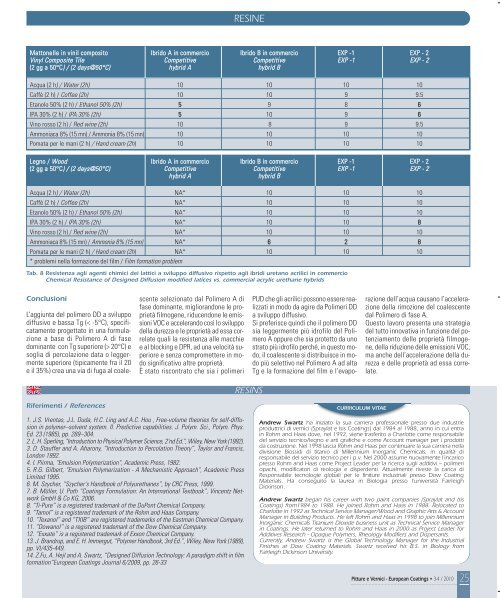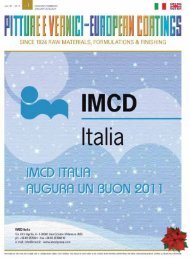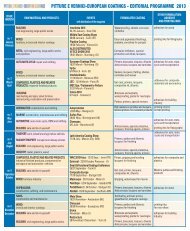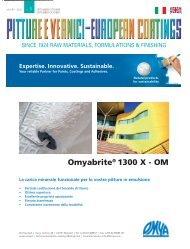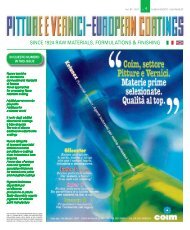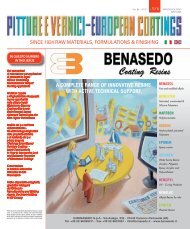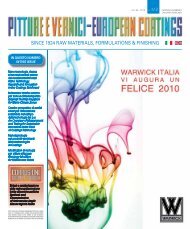Create successful ePaper yourself
Turn your PDF publications into a flip-book with our unique Google optimized e-Paper software.
Conclusioni<br />
L’aggiunta del polimero DD a sviluppo<br />
diffusivo e bassa Tg (< -5°C), specificatamente<br />
progettato in una formulazione<br />
a base di Polimero A di fase<br />
dominante con Tg superiore (> 20°C) e<br />
soglia di percolazione data o leggermente<br />
superiore (tipicamente fra il 20<br />
e il 35%) crea una via di fuga al coale-<br />
scente selezionato dal Polimero A di<br />
fase dominante, migliorandone le proprietà<br />
filmogene, riducendone le emissioni<br />
VOC e accelerando così lo sviluppo<br />
della durezza e le proprietà ad essa correlate<br />
quali la resistenza alle macchie<br />
e al blocking e DPR, ad una velocità superiore<br />
e senza compromettere in modo<br />
significativo altre proprietà.<br />
È stato riscontrato che sia i polimeri<br />
RESINE<br />
Mattonelle in vinil composito Ibrido A in commercio Ibrido B in commercio EXP -1 EXP - 2<br />
Vinyl Composite Tile Competitive Competitive EXP -1 EXP - 2<br />
(2 gg a 50°C) / (2 days@50°C) hybrid A hybrid B<br />
Acqua (2 h) / Water (2h) 10 10 10 10<br />
Caffè (2 h) / Coffee (2h) 10 10 9 9.5<br />
Etanolo 50% (2 h) / Ethanol 50% (2h) 5 9 8 6<br />
IPA 30% (2 h) / IPA 30% (2h) 5 10 9 6<br />
Vino rosso (2 h) / Red wine (2h) 10 8 9 9.5<br />
Ammoniaca 8% (15 mn) / Ammonia 8% (15 mn) 10 10 10 10<br />
Pomata per le mani (2 h) / Hand cream (2h) 10 10 10 10<br />
Legno / Wood Ibrido A in commercio Ibrido B in commercio EXP -1 EXP - 2<br />
(2 gg a 50°C) / (2 days@50°C) Competitive Competitive EXP -1 EXP - 2<br />
hybrid A hybrid B<br />
Acqua (2 h) / Water (2h) NA* 10 10 10<br />
Caffè (2 h) / Coffee (2h) NA* 10 10 10<br />
Etanolo 50% (2 h) / Ethanol 50% (2h) NA* 10 10 10<br />
IPA 30% (2 h) / IPA 30% (2h) NA* 10 10 8<br />
Vino rosso (2 h) / Red wine (2h) NA* 10 10 10<br />
Ammoniaca 8% (15 mn) / Ammonia 8% (15 mn) NA* 6 2 8<br />
Pomata per le mani (2 h) / Hand cream (2h) NA* 10 10 10<br />
* problemi nella formazione del film / Film formation problem<br />
Tab. 8 Resistenza agli agenti chimici dei lattici a sviluppo diffusivo rispetto agli ibridi uretano acrilici in commercio<br />
Chemical Resistance of Designed Diffusion modified latices vs. commercial acrylic urethane hybrids<br />
Riferimenti / References<br />
1. J.S. Vrentas, J.L. Duda, H.C. Ling and A.C. Hou , Free-volume theories for self-diffusion<br />
in polymer–solvent system. II. Predictive capabilities. J. Polym. Sci., Polym. Phys.<br />
Ed. 23 (1985), pp. 289–304.<br />
2. L. H. Sperling, "Introduction to Physical Polymer Science, 2'nd Ed.", Wiley, New York (1992).<br />
3. D. Stauffer and A. Aharony, “Introduction to Percolation Theory”, Taylor and Francis,<br />
London 1992.<br />
4. I. Piirma, "Emulsion Polymerization", Academic Press, 1982.<br />
5. R.G. Gilbert, "Emulsion Polymerization - A Mechanistic Approach", Academic Press<br />
Limited 1995.<br />
6. M. Szycher, “Szycher's Handbook of Polyurethanes”, by CRC Press, 1999.<br />
7. B. Müller, U. Poth “Coatings Formulation: An International Textbook”, Vincentz Network<br />
GmbH & Co KG, 2006.<br />
8. “Ti-Pure” is a registered trademark of the DuPont Chemical Company.<br />
9. “Tamol” is a registered trademark of the Rohm and Haas Company.<br />
10. “Texanol” and “TXIB” are registered trademarks of the Eastman Chemical Company.<br />
11. “Dowanol” is a registered trademark of the Dow Chemical Company.<br />
12. “Exxate” is a registered trademark of Exxon Chemical Company.<br />
13. J. Brandrup, and E. H. Immergut, “Polymer Handbook, 3rd Ed.”, Wiley, New York (1989),<br />
pp. VI/435-449.<br />
14. Z.Fu, A. Hejl and A. Swartz, “Designed Diffusion Technology: A paradigm shift in film<br />
formation”European Coatings Journal 6/2009, pp. 26-33<br />
RESINS<br />
PUD che gli acrilici possono essere realizzati<br />
in modo da agire da Polimeri DD<br />
a sviluppo diffusivo.<br />
Si preferisce quindi che il polimero DD<br />
sia leggermente più idrofilo del Polimero<br />
A oppure che sia protetto da uno<br />
strato più idrofilo perché, in questo modo,<br />
il coalescente si distribuisce in modo<br />
più selettivo nel Polimero A ad alta<br />
Tg e la formazione del film e l’evapo-<br />
CURRICULUM VITAE<br />
razione dell’acqua causano l’accelerazione<br />
della rimozione del coalescente<br />
dal Polimero di fase A.<br />
Questo lavoro presenta una strategia<br />
del tutto innovativa in funzione del potenziamento<br />
delle proprietà filmogene,<br />
della riduzione delle emissioni VOC,<br />
ma anche dell’accelerazione della durezza<br />
e delle proprietà ad essa correlate.<br />
Andrew Swartz ha iniziato la sua carriera professionale presso due industrie<br />
produttrici di vernici (Spraylat e Isis Coatings) dal 1984 al 1988, anno in cui entra<br />
in Rohm and Haas dove, nel 1992, viene trasferito a Charlotte come responsabile<br />
del servizio tecnico/legno e arti grafiche e come Account manager per i prodotti<br />
da costruzione. Nel 1998 lascia Rohm and Haas per continuare la sua carriera nella<br />
divisione Biossidi di titanio di Millennium Inorganic Chemicals, in qualità di<br />
responsabile del servizio tecnico per i p.v. Nel 2000 assume nuovamente l’incarico<br />
presso Rohm and Haas come Project Leader per la ricerca sugli additivi – polimeri<br />
opachi, modificatori di reologia e disperdenti. Attualmente riveste la carica di<br />
Responsabile tecnologie globali per le finiture industriali presso Dow Coating<br />
Materials. Ha conseguito la laurea in Biologia presso l’università Fairleigh<br />
Dickinson.<br />
Andrew Swartz began his career with two paint companies (Spraylat and Isis<br />
Coatings) from1984 to 1988. He joined Rohm and Haas in 1988. Relocated to<br />
Charlotte in 1992 as Technical Service Manager/Wood and Graphic Arts & Account<br />
Manager in Building Products. He left Rohm and Haas in 1998 to join Millennium<br />
Inorganic Chemicals Titanium Dioxide business unit as Technical Service Manager<br />
in Coatings. He later returned to Rohm and Haas in 2000 as Project Leader for<br />
Additives Research - Opaque Polymers, Rheology Modifiers and Dispersants.<br />
Currently, Andrew Swartz is the Global Technology Manager for the Industrial<br />
Finishes at Dow Coating Materials. Swartz received his B.S. in Biology from<br />
Fairleigh Dickinson University.<br />
Pitture e Vernici - European Coatings • 3-4 / <strong>2010</strong><br />
25


